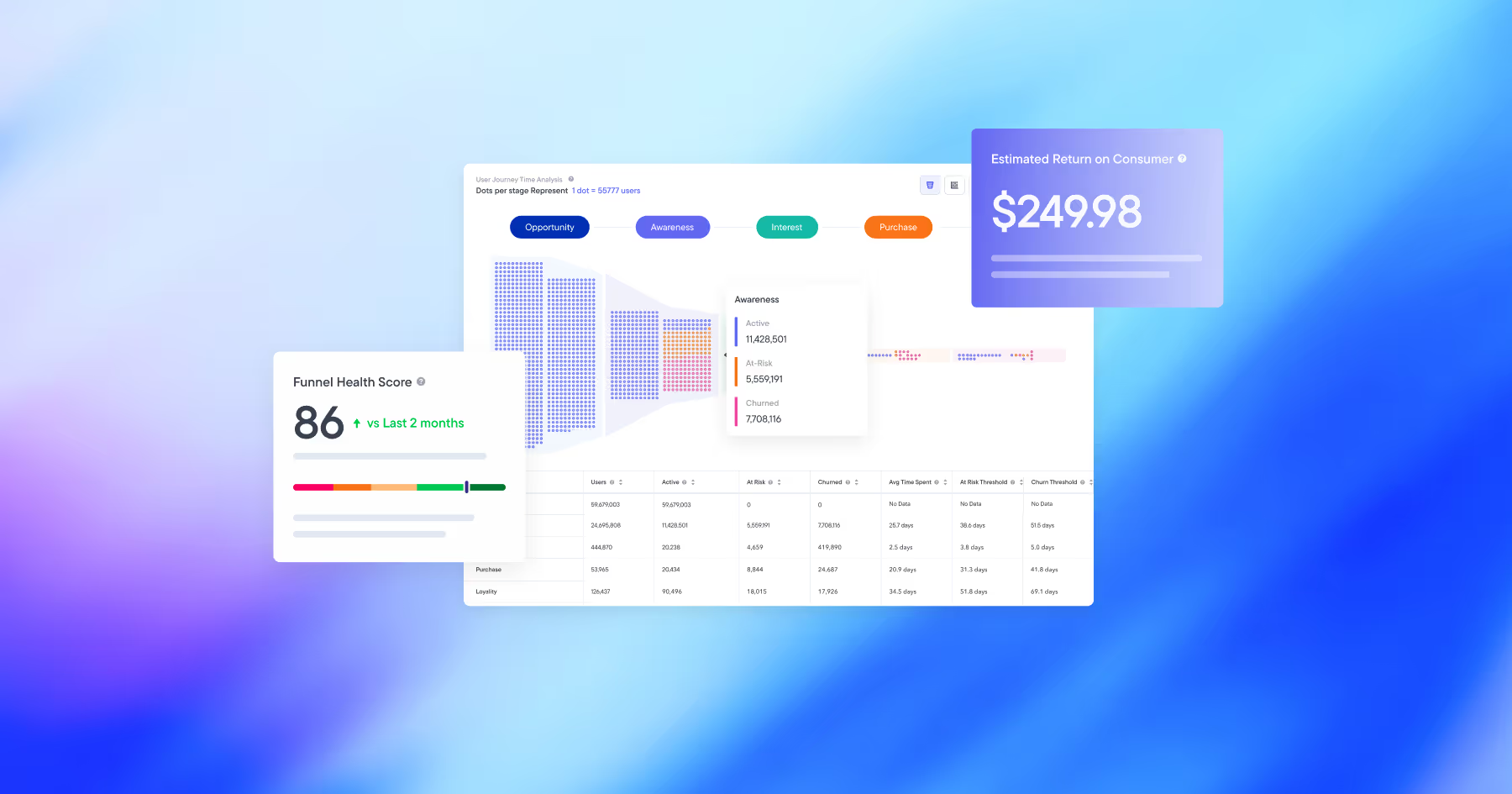
Brands looking to engage with consumers at the most important points on their paths to purchase need to build bespoke AMC Audiences for accurate reach. Building custom AMC Audiences utilizing a full funnel analysis powered by AMC data isn't simple - but below we’ve broken it down for you so that your brand can not only understand your customer's paths to purchase on a more granular level, but you can then engage them more efficiently along the path.
In this analysis, we compare BFCM path to purchase behavior to a non-deal event baseline in order to show how an AMC Audience could be built to reach shoppers more efficiently during the next deal event.
While this specific example looks at improving engagement during a deal event, the process of building a baseline using AMC full funnel analysis can be used to build custom AMC Audiences for better marketing across specific segments, brands, or time periods.
To show how this works, we've broken down the process into three steps:
- Step 1: Establish a baseline
- Step 2: Analyze the data and draw conclusions
- Step 3: Turn conclusions into actions
“The Path to Purchase has always been rich data to analyze, but with low actionability. Ever since the capability to create AMC Audiences was released, we can really leverage this data to enhance brand’s strategies and reach shoppers where they are most likely to purchase.” Gloria Steiner, Director of Data Intelligence, Flywheel Digital
Step 1: Establish a baseline
Key takeaway: Establishing a comparison baseline is critical in a full-funnel AMC analysis, which helps benchmark the performance of specific segments, brands, or time periods.
When you're looking at a full-funnel AMC analysis, there are various approaches you can take to analyze the customer path to purchase. For simplicity, we'll start with an overall user group consisting of all those who've seen any Sponsored Ads, and then focus on the percentage of users that reach each subsequent stage of the funnel:
- Visited Product Detail Page (PDP)
- Added to Shopping Cart
- Completed Purchase
- Activated Subscribe & Save
Now you're ready to set up a baseline. As a rule, if you want to understand any dataset, you need a point of reference that tells you whether a number is high, low, or the greatest result in your company's history.
The purpose of a baseline is to capture your normal performance, but it isn't always easy to define normal. There are, however, a few elements to be aware of:
- Exclude any peak shopping periods. If you use Prime Day data as your baseline, everything will look low in comparison.
- Ensure the data is representative. If 95% of your data comes from one SKU, it's ill-suited to cover your entire catalog.
- Use the same query structure and consistent calculation methodology. This will ensure you're comparing like with like.
As an example, we've pulled AMC data from a selection of US advertisers for an eleven-day period, Oct 21-31 2023, to establish our baseline percentages for how user move down the funnel:

Done thoughtfully, your baseline metrics will be the foundation you need for drawing accurate conclusions. They'll be more actionable than generic industry benchmarks, when it comes to dictating strategy.
Step 2: Analyze the data and draw conclusions
Key takeaway: When designing your AMC analysis, be sure to isolate segments, categories or time periods. Then compare results with your baseline to get a true reflection of performance.
The next step is running your analysis and comparing it with your baseline. In our example, we've chosen a specific time period, but our team of AMC experts at Flywheel can help your brand define which metrics to investigate such as customer behavior across categories, brands, individual ASINs, or any other segment of interest based on your goals.
For this example, we've picked out three days during the last Black Friday deal period, and run the full-funnel analysis, comparing to our established, non-peak baseline, for each of:
- Day 1 of the 11-day deal period (Nov 17, 2023)
- Black Friday (Nov 24, 2023)
- Cyber Monday (Nov 31, 2023)
Here are the results, in each case compared with the respective baseline rate seen in the above section:
.avif)
Immediate takeaways from these findings include:
- Huge increase in percentage of shoppers visiting PDPs on day 1 of the deal period, coupled with a large fall in add-to-cart percentages: Shoppers are looking at more options when deals first go live.
- Completed purchase percentage (having added to cart) is higher on Black Friday and Cyber Monday than at normal times: Users are NOT filling baskets to secure deals and then bouncing.
Subscribe & Save rates are down throughout the deal period: Subscription-friendly products are NOT the focus of Black Friday Cyber Monday customers.
Step 3: Turn your insights into action
Key takeaway: With AMC Audiences, you can leverage your full-funnel insights to reach highly granular customer groups at the touchpoints where they're leaving the funnel. The level of customization makes it possible to run tactical campaigns not possible with standard DSP tactics.
This final step is where the rubber meets the road. Can you take action based on the outcome of your analysis? For brands using AMC, the answer is simple: yes you can—by using what you've learnt to inform the creation of AMC Audiences.
AMC Audiences case study
For a clothing brand looking to increase the completed purchase percentage, we created audiences to engage with precisely those who had added one of the brand's ASINs to cart in the last 90 days, but had not converted. Two separate audiences (one for the men's and one for the women's category) enabled the implementation of highly tailored re-marketing, with impressive results:

Say you find—as we did above—that a certain segment of your analysis has an above-average PDP view, but below-average add-to-cart percentage. While one obvious move would be to review the relevant PDPs from a content optimization standpoint, you can also build an AMC Audience comprising those users who have exited the funnel at this stage.
You can then run an ad campaign to re-engage this audience and give them a second chance to convert—or you can advertise alternative products to them—maybe they didn't add-to-cart because the product wasn't quite the right option.
We can't give one-size-fits-all recommendations, and we wouldn't be being honest if we did, as the precise implementation will depend on your specific use case, but the good news is: with AMC you have the data you need and your options are (near) limitless.
Find out more about Flywheel's Amazon Marketing Cloud services and learn how you can build your own custom audiences here.
Data disclaimer
The findings in this article are based on Amazon Marketing Cloud data available to Flywheel. While Flywheel, thanks to its close relationship with Amazon and its extensive client base, has unrivaled access to Amazon Marketing Cloud data, the results presented here should not be considered representative of the official performance of Amazon Advertising, nor of that of any individual advertiser.
Ready to grow your business?
Let’s discuss the best approach to meet your brand’s specific needs.
Let's connect


